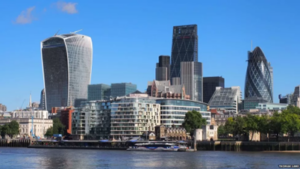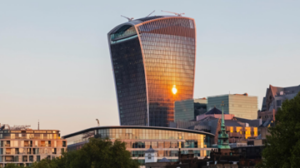From Talkie to Scorchie: the Fenchurch Controversy
Aidan Dowell
We spend almost all of our lives moving from building to building—for food, for fun, for sleep, for work—and yet rarely do these buildings become truly important subjects in our lives. The 20 Fenchurch Street Building in London didn’t become a spectacle because of its controversial style, gargantuan size, or sustainable infrastructure, but rather because it became a 500-foot-tall laser gun, scorching the neighboring London streets. Thus, its nickname “the walkie-talkie” quickly became “the walkie-scorchie” to many London locals. Ultimately, despite the Walkie-Talkie’s short existence, having only opened in 2015, its life so far has been filled with lessons on the state of London’s modern architecture and the hubris of so-called celebrity architects.
The Walkie-Talkie is certainly not the first of its kind, with two main predecessors also promptly jutting out of the London skyline. The first being the 30 St Mary Axe building, erected in 2001, similarly nicknamed the Gherkin for its appearance as a giant, conic, glass pickle in the middle of the city. The other, the Leadenhall building, started construction just about the same time as the Walkie-Talkie and juts out of central London like a glass doorstop. However, the Walkie is often charged with being the primary offender of this game of building the biggest and silliest glass building in all of London. If the modernist office building can be characterized as a solid glass rectangle coming to an urban landscape near you, then the Walkie-Talkie is its child with the principles of postmodernism. While it maintains the steel, glass, and stature of a modern skyscraper, it rejects the perfect geometry of the familiar box by contorting each of its surfaces. Two sides balloon out like convex ax heads, united by a pair of giant’s shoe horns, all topped by a glass roof smoothed down to meet the building’s irregular corners. The Walkie feels eerily uncanny, taking each aspect of the box and literally warping them, welded with a thick white trim like icing holding together a child’s gingerbread house. That isn’t to say the Walkie is completely meritless. Rippling panels of blue glass shaded by the sun actually help the behemoth start to blend in with the River Thames below, and a sky garden on the uppermost levels works to enliven the urban scape with shrubs, trees, and green grasses. But the Walkie’s failure to commit to a style puts it at war with itself, overshadowing the building’s integration with its environmental context.

From left to right, the Walkie Talkie, the Leadenhall building, and the Gherkin photographed by Thomas Lane for the BBC
For Rafael Viñoly, architect of the Walkie-Talkie, oversized and ill-fitting is the name of the game. Viñoly’s work around the world can all be characterized by wanting to be the best, or at least the biggest—The Al Jazira Football Club in Abu Dhabi, the Boston Convention and Exhibition center, or the Curve Theater in Leicester to name just a few. This goal is captured in Viñoly’s digital portfolio, where the Fenchurch building is listed as “offering stunning views of London and a new landmark for the capital”(“20 Fenchurch Street”). Clearly, the architect believes that by the sheer magnificence of his work, London would bow in honor at its new Eiffel Tower or Statue of Liberty, a testament to Viñoly’s raging ego. Put best by Yale architecture professor Aaron Betsky for the Journal of the American Institute of Architects, “[Viñoly’s] creations are among the most banal, badly organized, and insensitively scaled of any designed by a name-brand architect.” He, too, frowns on the Walkie’s melted plastic effect, shunning the “alien and alienating curves”(Betsky). But this contention with the building’s curvature is about more than just the building’s aesthetic appeal, or lack thereof. In fact, it’s the source of the Walkie-Scorchie narrative.
Where Viñoly’s ego truly becomes hubris is in the gross oversights made to achieve his “new landmark.” The concavity of the Walkie’s front not only catches the sun in a way that heats the building to uncomfortable temperatures, but reflects light straight down at the streets below (as pictured in the photo to the left). Gemma Mullins reports for MailOnline that the strong sun had “buckled” the side of a black Jaguar XJ, punctured bicycle seats, and ignited doormats of neighboring businesses (Mullin). Ryan Danks, a building engineering consultant, measured that neighboring surface temperatures “regularly exceeded 111℉”(Danks et al.). Causing such extreme heat made the Walkie Talkie an unignorable public hazard. In all, it seems like a pretty tremendous error for Viñoly to make. Betsky chocks this egregious oversight up to the inability of new, intricate 3-D modeling software to “have [modern building] designs respond to either our bodies and our social lives or to existing context.” Perhaps more upsetting than Viñoly and his software’s failure to acknowledge a blatant problem, was their extremely late implementation of an equally recognizable solution. Since the Walkie’s wave of solar destruction, it was fitted with a brise soleil in 2014, which is essentially an oversized sun screen (Mullin). Brise Soleils aren’t anything new, though. In fact, it’s commonplace to fit any large glass building with such a shade. As ridiculous as having a glass canopy with no shade is, on its own, it says to “everyone who is not an architect” that “architects are absentminded, sloppy, and incompetent”(Betsky).

The Walkie Talkie reflecting the sunset, captured by Michael Cross for the Law Society Gazette
After discovering this strange history of the Walkie, my mind was filled with “hows.” How was this design approved? How was Viñoly trusted to erect another of his eye sores? How is the building still up after causing so much destruction? But the answer to all of my hows was as bleak and uninspired as the Walkie itself: it does its job. To the utilitarian, the Walkie Talkie is a dream more than a nightmare. The Walkie has “32 floors of Grade A office space,” combined with floor plates that get larger as you move up the building, resulting in more functional space with each level (“20 Fenchurch Street”). It incorporates greenery in the park around its base and the sky garden at its peak, and even mitigates its own carbon and greenhouse gas emissions.
With its ergonomic value, The Walkie Talkie could very well be the future of London’s office buildings, but the Walkie cannot be the future of London’s architecture. In Paul Goldberger’s book, Why Architecture Matters, he presents the “conflicting values of architecture,” as defined by Vitruvius (7). These values can be understood as the aesthetic appeal of a building, the effectiveness of the design of a building, and the building’s ability to fulfill its function; the Vitruvian tripartite. We can see this manifested in the Walkie Talkie through the building’s bizarre style, hazardous design, and utilitarian function. Each of its facets are prominent and well understood, yet not created equal. Goldberger elaborates on the structure of the tripartite, stating that “without firmness and delight, commodity is nothing”(7). From this, we can understand that the sides of the Fenchurch building, much like in the literal sense, are uneven and unbalanced. No matter how efficient or renewable the Walkie Talkie might be, its design that destroys the surrounding environment and aesthetic that feels completely mismatched with its context will prevent it from being considered truly good, let alone exemplary architecture.
The contributions the Walkie could have contributed to conversations of modern sustainability, such as sustainable energy sources, the incorporation of natural and vegetal biomes, and the monopolization of ground space, are spoiled by the joint ignorance and ego of an architect too big for his britches. It’s not quite fair to say that the Walkie Talkie will never be anything but just an eyesore, though.
It’s an eyesore that melts cars.
Works Cited
“20 Fenchurch Street.” Rafael Viñoly Architects, https://www.rvapc.com/works/20-fenchurch-street/. Accessed 2 Feb. 2023.
Betsky, Aaron. “How a Rafael Viñoly Skyscraper Melted a Jaguar in London.” Architect, 6 September 2013, https://www.architectmagazine.com/Design/how-a-rafael-vinoly-skyscraper-melted-a-jaguar-in-london_o.
Danks, Ryan, et al. Avoiding The Dreaded Death Ray: Controlling Facade Reflections Through Purposeful Design. October 2016.
Goldberger, Paul. “Why Architecture Matters.” Yale University Press, New Haven and London, 2009.
Mullin, Gemma. “No More Walkie Scorchie! London Skyscraper Which Melted Cars by Reflecting Sunlight Is Fitted with Shading.” Mail Online, 9 Oct. 2014, https://www.dailymail.co.uk/news/article-2786723/London-skyscraper-Walkie-Talkie-melted-cars-reflecting-sunlight-fitted-shading.html
